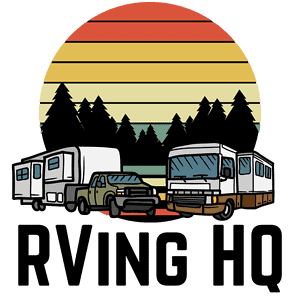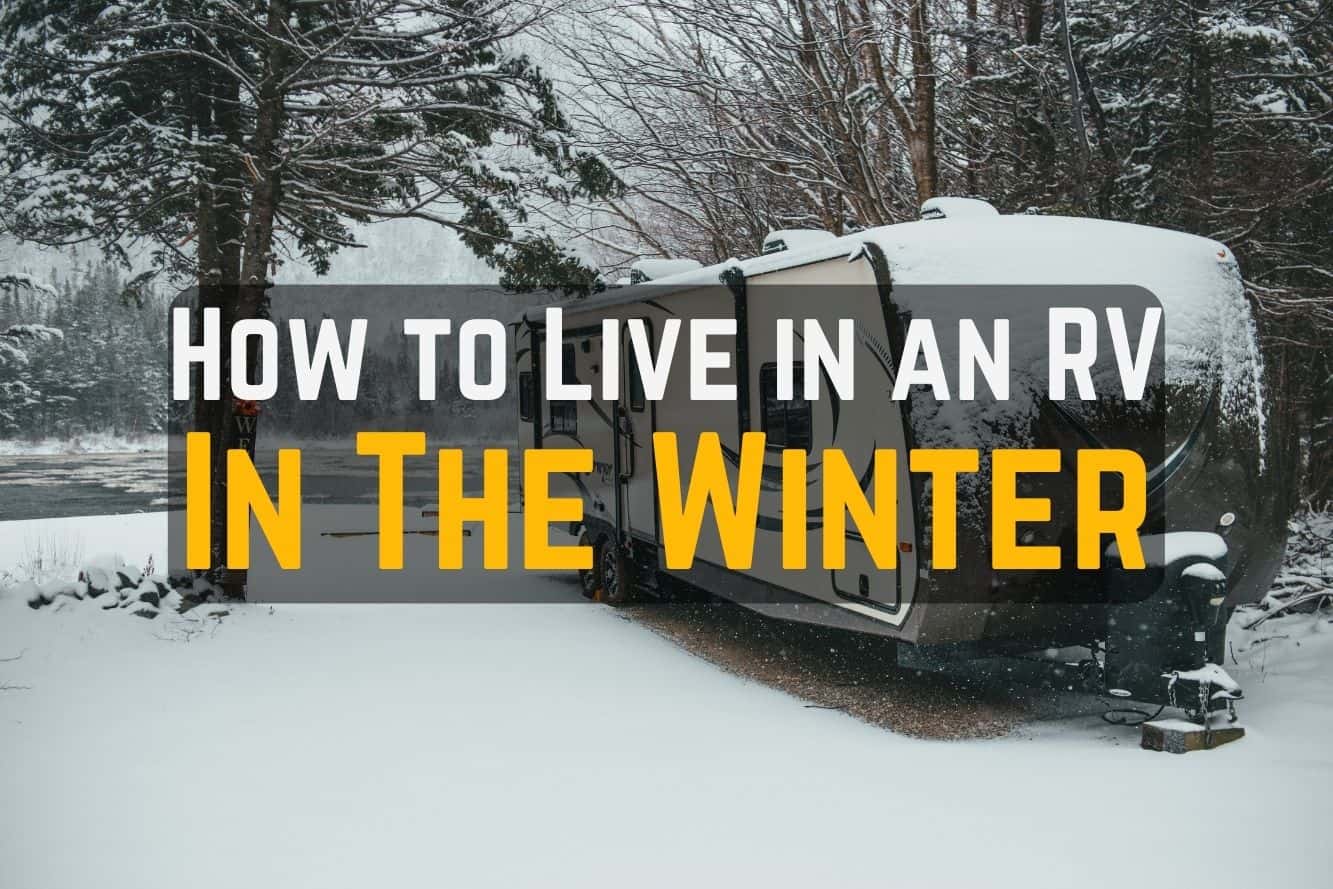Learning how to live in an RV in the winter time requires just a handful of things: insulation, heating, fire and CO2 safety, and protecting your plumbing.
But these few things can get really in-depth, and there’s a variety of different ways to do them!
In this article, you’ll learn how to live in an RV in the winter time comfortably and safely. Let’s dive in.
This article contains affiliate links. This means if you make a purchase after clicking a link on our site, we may earn a small commission.
Table of Contents
Can You Live in an RV During Winter?
Yes, you can live in an RV during the winter, and many people do! Whether stationary or traveling, living in an RV is a great way to save money and see the country, and you can do it in any season.
The key to comfortably living in an RV during the winter time is to be prepared. This article is meant to be an in-depth winter RV living guide. We’ll touch on every aspect of winter RV living to help you better prepare for the cold winter months.
Note: this article pertains to winter RV living in colder climates.
Also, we use the term RV to apply to all types of campers: motorhomes, fifth wheels, and travel trailers.
Considerations for Full-Time RV Living in Winter Time
Before we get into it, let’s briefly highlight the main topics this guide covers.
- Stationary winter RV living vs full time winter travel.
- Insulating the interior and exterior of your RV.
- Heating your RV and the many ways to do it.
- Protecting your RV plumbing system from freezing.
- Moisture management in the winter (condensation, humidity, etc).
- Fire safety when using space heaters and heating equipment.
- What to do if your RV pipes freeze.
- Inclement winter weather in your RV.
- Tips for traveling in your RV during the winter.
If you’re short on time, use the table of contents to jump to the sections that interest you the most. Let’s get started!
Stationary FullTime RV Living vs Full-Time Winter RV Travel
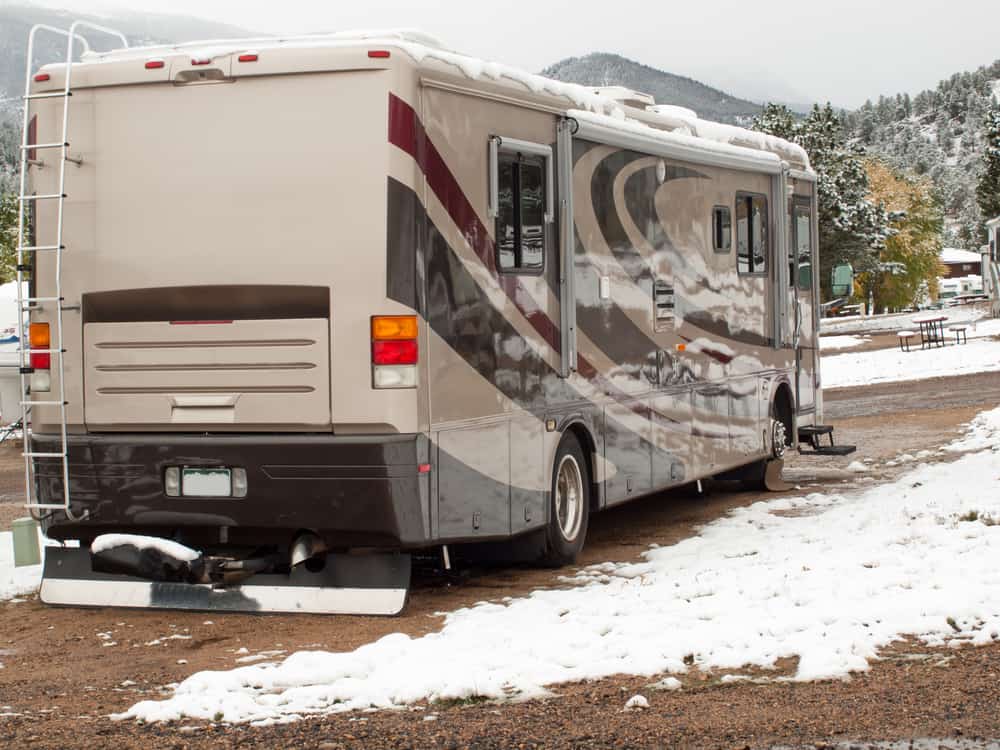
It is possible to comfortably live in your RV in cold winter weather while traveling, and it’s also possible while stationary.
In fact, if you’re stationary, it will be much less work!
The topics that we cover in this guide like insulation, heating, and protecting your RV plumbing all require work. But if you are a full-time RVer who is stationary, you only have to do it at the start of the season and you can use more permanent options that can remain in place all season long.
If you’re traveling, you may have to do it every time you set up camp. Luckily, there are temporary options for just about every method mentioned here.
Nobody said RVing was easy, but we think it’s worth it… and you probably agree if you’re still reading this.
Related: RV Types & RV Classes: Types of RVs Explained (Pros & Cons)
Insulating Your RV for Winter Living
Not all RVs are made equal. Some might claim to be 4-seasons, but the reality is: RV insulation is nothing like house insulation.
And the older your RV, the less effective the insulation may be. There are certain areas in your RV that are more prone to letting in cold air and drafts, and those are what you should focus on insulating.
Here are the main areas to consider insulating:
- Your RV Underbelly
- Windows
- Skylights
- Slide outs
Insulating Your RV Underbelly
You can insulate the underbelly of your RV most effectively with RV skirting. There are DIY RV skirting options as well as quick and easy custom skirting.
Your RV underbelly is the underneath of your RV. Some RVs have enclosed underbellies, and others are exposed. That means some of your plumbing is totally exposed to the elements – but insulation can help!
Insulating your RV underbelly is also important to help keep the interior of your camper warmer.
Since your camper sits up off the ground, this allows the cold winter air to hit every side of it. The walls, the ceiling, and the underbelly.
Cold winter wind whipping past and beneath your RV can pull the warmth out quickly! So, if you insulate your RV underbelly, you simultaneously help to control the temperature inside of your camper.
DIY RV Skirting
DIY RV skirting can be done for relatively cheap. You can use materials like foam board, tarp, or canvas to skirt your RV. Foam board RV skirting isn’t the best option for full-time RV travelers, but it is effective if you’re stationary.
Caution: Although some RVers may recommend it, we strongly advise against using hay bales to insulate your RV underbelly. Hay bales attract pests like mice, bugs, and snakes. They also harbor moisture and quickly rot and grow mold. And perhaps worst of all, hay bales packed under your RV perimeter are a fire hazard.
Custom RV Skirting
Custom RV skirting options can be purchased online, and this will probably be your best bet if you’re traveling.
A quick and easy solution is inflatable RV skirting. All you have to do with this type of skirt is lay it out and inflate it! It’s very simple and a great option if you’re traveling.
Insulating RV Windows
The more windows your RV has, the more cold it probably feels inside. And if you’re in a motorhome, you also have a windshield and cab windows to deal with!
There are many methods to insulate your RV windows. You can use reflective bubble wrap insulation cut-to-size to help keep your RV interior warmer. However, this type of RV window insulation blocks out natural light–something we could all use more of in the winter!
You can also insulate your RV window by using heat-shrink window film. This clear film creates an insulating barrier of air between your RV window and the interior of your RV, and you can still see outside.
For motorhomes, you can use reflective insulation for your windshield and cab windows, or just hang curtains to block the cab off from the rest of your RV.
Insulating Your Skylight and Vents
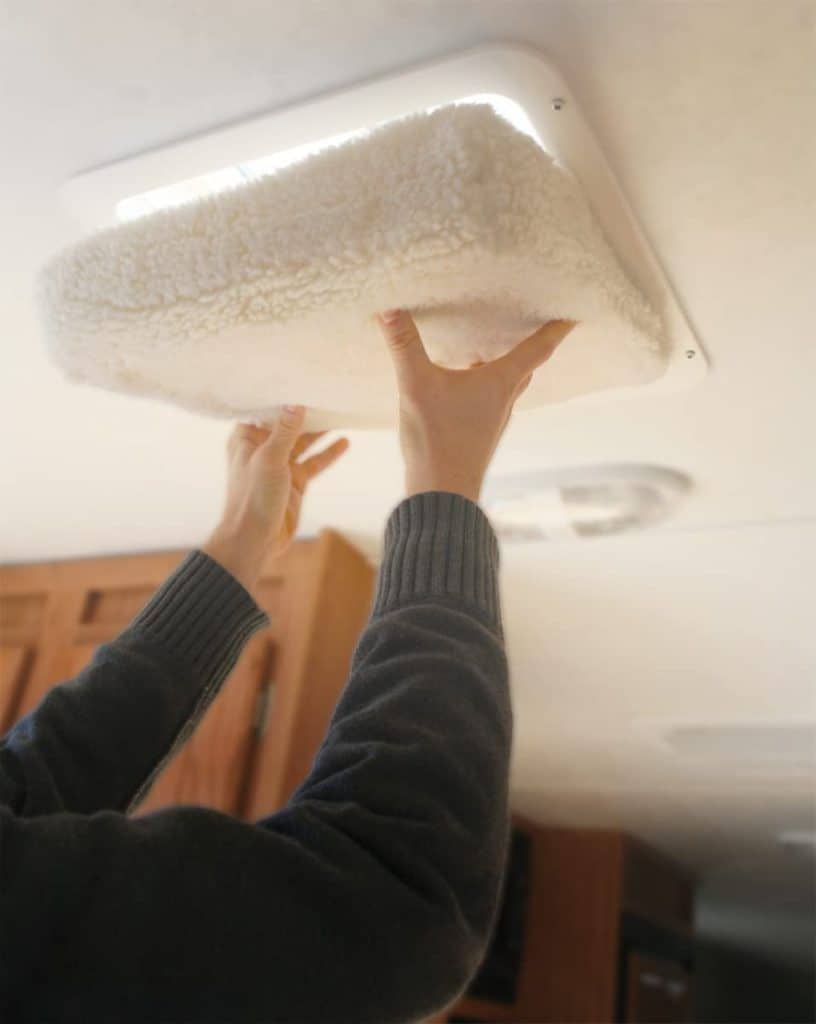
Most RVs have at least one skylight and a roof vent fan or two. These are prime areas for cold air and drafts!
You can insulate your RV skylight with the same shrink-wrap clear film that you use on your RV windows.
And for your vents, you can use these handy RV vent insulation pillows that are easily removable when you need to use the fan.
Insulating RV Slide Outs
Your RV slide outs are another area that are prone to letting in cold air and drafts. Try as they might, RV manufacturers can only insulate slide outs so much.
The main areas that RV slides let in cold air is around the seal and the windows.
You can insulate your RV slide outs by making sure your seals are clean and free of debris. If you still feel cold air coming in through them, you can tuck weather stripping into the lip of the slide out seal to help block cold air.
If you’re stationary, you can use a slide out blanket to further insulate the walls of your RV slide.
And, of course, insulating your RV slide out windows with shrink-wrap window film will help keep this area nice and cozy.
Insulating Your RV Floors
Waking up and stepping on a cold floor on a winter morning is an unpleasant experience, to say the least.
You can help insulate your RV floors and make them more comfortable to walk on by using thick rugs during the winter time.
Heating Your RV for Winter Living
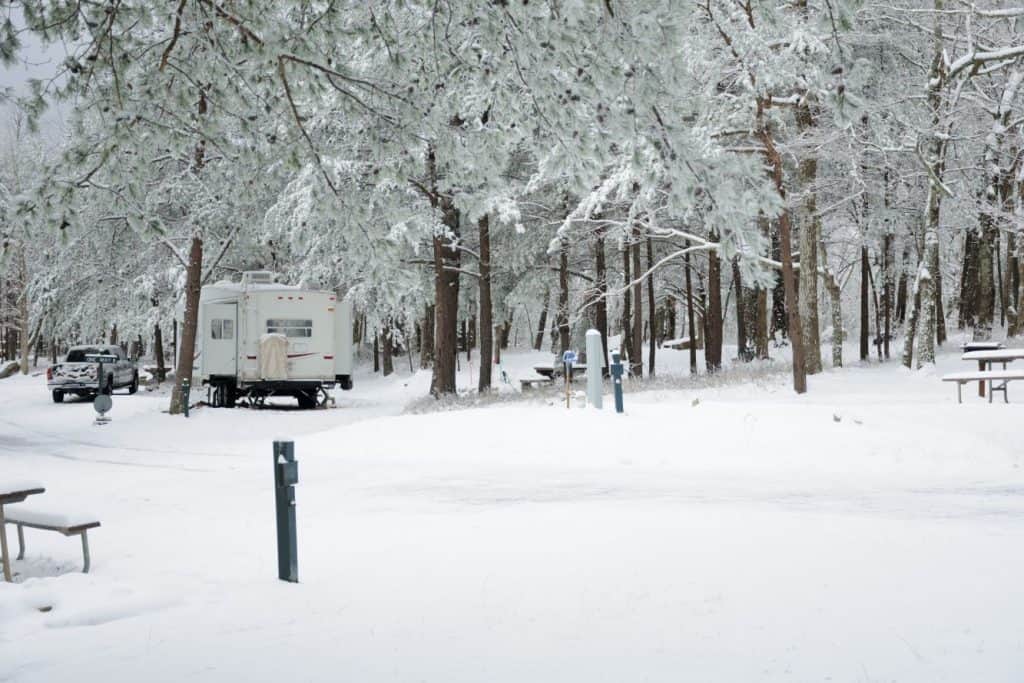
Most motorhomes, travel trailers, and fifth wheels come with some type of heat source, like a furnace.
Most RV furnaces are propane powered, so you will need to make sure that you keep your RV propane tank topped off during the winter time.
If you are stationary at a campground or RV park, you can get propane delivery. Sometimes the campground will provide this service, but almost every local area has a company that will come out to you if not.
You can also use space heaters to help heat your RV – both electric and propane powered. The Mr. Buddy heater is an excellent propane space heater and one we’ve used for years in our RV, but it can’t be left on unattended or while you sleep.
If you want to heat your RV without propane, you can use electric space heaters, install a diesel heater in your camper, or install an Alde hydronic heating system, which uses hot water to heat your RV.
If you choose to use an electric space heater, be sure that your RV electrical system can handle the power draw. And NEVER use a regular extension cord with a space heater as it is a major fire hazard and the cause of hundreds of fires every winter.
Heating Your RV Holding Tanks
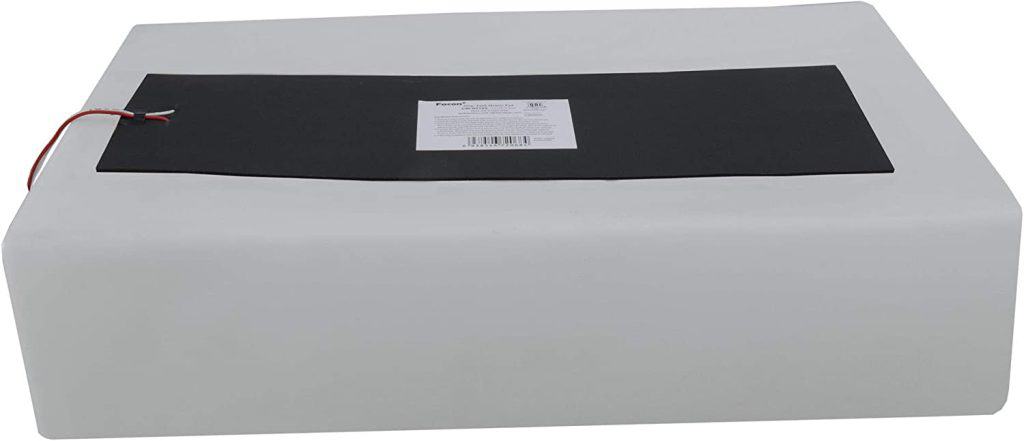
Your RV holding tanks need love, too! Especially if you don’t have a “4 season” RV.
Most RVs have 3 – 4 holding tanks. A fresh water tank, a gray water tank, and a black water tank.
If you have a large RV like a fifth wheel or toy hauler, you may have multiple gray water tanks or multiple black water tanks.
Each of these water tanks should be protected from freezing, because a frozen tank can crack, cause leaks, and be ridiculously expensive to repair.
And repairing a cracked black tank is something we don’t wish upon any RVer or RV technician…
Some RVs have RV tank heaters that you can turn on and off with a switch located somewhere inside the RV. This is basically just a giant heating pad that helps keep your tanks warm.
And some RVs have furnace ducts to the areas where the tanks are held to help keep the ambient temps above freezing.
But if you don’t have any of these options, you can help heat the tanks yourself. You can do this by:
- Installing RV tank heaters on your tanks to prevent freezing.
- Skirting your RV underbelly to keep your RV tanks from freezing.
- Creating a DIY heating duct to your tanks.
- Keeping a continuous supply of RV antifreeze in your gray and black tanks.
- Keeping your fresh water tank completely full (60 gallons of water takes significantly longer to freeze than 10 gallons).
How to Protect Your RV Plumbing from Freezing
Protecting your RV plumbing from freezing might just be the most important thing you do when living in your RV in the winter. There are a variety of ways to prevent your pipes and plumbing from freezing. You can use a heated water hose, heat tape around your plumbing, and make sure the area that holds your pipes and tanks stays above freezing.
If your RV pipes freeze, they’re very likely to crack when they thaw. This causes leaks, water damage, and is a huge headache to repair–not to mention a huge hit to your wallet.
In an RV, it is not recommended to drip your sink during freezing weather. You should keep your gray tank closed during freezing weather to protect your sewer hose from freezing, and dripping your faucets will cause your tank to fill up faster than usual.
Protecting RV Pipes and Holding Tanks
For many RVs, the pipes that run water to your sinks, appliances, and toilets are located in the storage bays or RV underbelly.
You can keep these pipes above freezing by using heat tape along the pipes, ducting a heater into the area that holds your plumbing, and skirting your RV.
Protecting Your Hoses
If you are about to have a day or night of below-freezing temps, it’s best to fill up your fresh water tank and disconnect your potable water hose.
A full fresh water tank will take much longer to freeze than a half-full tank, and by disconnecting your hose, you don’t have to worry about it freezing.
Alternatively, you can use a heated potable water hose and insulate the spigot of the campground.
Additionally, you should close your gray tank and remove your sewer hose. Only empty your gray and black tanks once they become full, and rinse and store your sewer hose after each time you dump.
This will help prevent your sewer hose from freezing or cracking in freezing winter temperatures.
Protecting Your RV Water Heater
Your RV water heater is another area that can freeze easily in cold weather. To protect your water heater, you have two main options.
- Keep your water heater on 24/7. This is a typical arrangement for people who live in their RVs full-time.
- Drain your water heater when temps are forecast to drop below freezing. This is more applicable to part-time RVers or campers. Doing this means you won’t have hot water!
RV Moisture Management in the Cold Winter Months
If you’re new to RVing, you might not know that moisture is a major problem for RVers in the winter.
In houses, the lack of humidity is a problem in winter time. But in RVs, it’s the opposite.
The reason for that is both the small space of the RV and the high-humidity activities we do like cooking and showering… and propane.
Did you know that for every gallon of propane burned by an RV furnace, an average of 1.6 gallons of moisture is released into the air as water vapor? It’s true!
As such, controlling moisture and condensation is a never-ending battle for RVnig in the winter time.
For full-time RV living in the winter, we recommend a combination of a dehumidifier in the large common spaces of your RV, and using DampRid in cabinets and closets to help control moisture.
RV Fire and CO2 Safety in the Winter Time
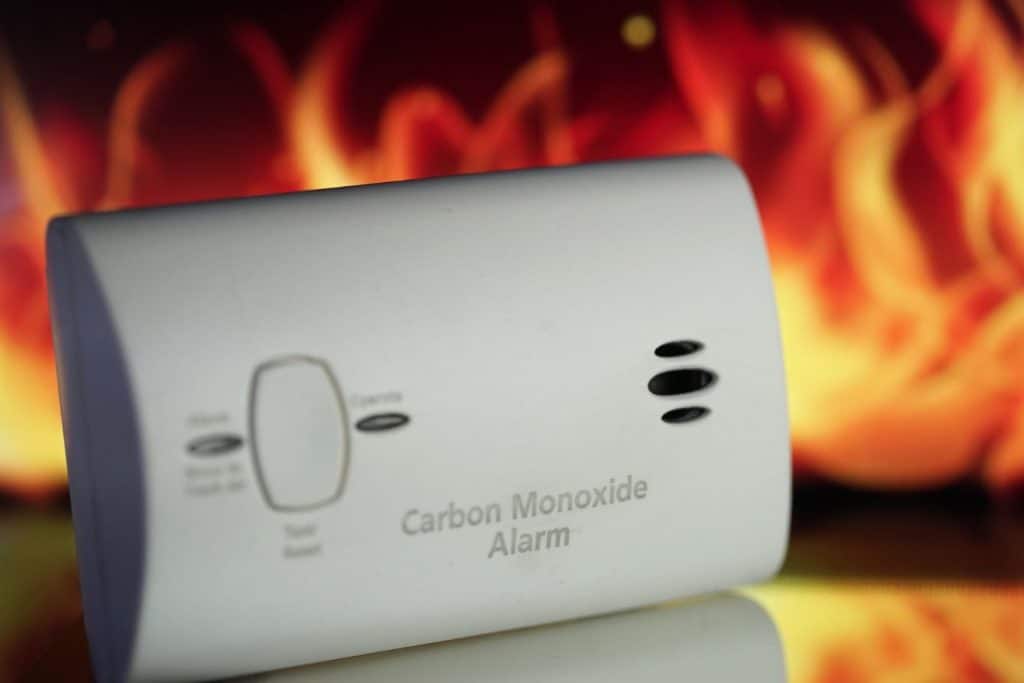
You should be cognizant of RV fire safety at all times of year, but cold winter months may need increased awareness. This is especially true for carbon monoxide, which is an odorless, tasteless, invisible gas that can be fatal.
Here are some RV fire safety and carbon monoxide tips for winter time.
- Use a carbon monoxide alarm in all main living and sleeping areas of your RV, and test them monthly.
- Never use an extension cord for an electric space heater.
- Never use a power strip for an electric space heater.
- Never leave a propane heater running unattended, such as while you’re outside or asleep.
- Keep your RV electrical system in good working order.
- Have your RV propane system inspected annually.
- Do not use hay to skirt your RV.
What to Do if Your RV Pipes Freeze
If your RV pipes freeze, you should check for cracks, check your water pump, and then get to work thawing them out.
You can thaw out your RV pipes in a few ways: using a heat gun or hair dryer, using heat tape around the pipes, or using a space heater.
If this is a job you feel unprepared to do yourself, you can also call a plumber.
It is very common for your RV pipes to crack when they freeze, but sometimes you might get lucky and not experience any cracking if it’s a light freeze.
If your pipes crack and you have a leak once they’ve been thawed out, you should address the leak immediately.
A great short-term solution to patching a leaking pipe is to use a product like Flex Seal tape. This tape can be applied to an active leak and it stops leaks instantly. However, you should still try to replace the pipe as soon as possible.
Snow, Ice, and Yucky Winter Weather
Snow, ice, and yucky winter weather are just a fact of life when you live in an RV in the winter.
Most times, they will cause no problems and need no special preparations other than your usual winter RVing prep.
However, if you are in an area that gets a ton of snow, you may need to try to keep your camper roof clear so that the weight of the snow doesn’t cause any issues.
Snow on your camper roof isn’t a bad thing until it becomes excessive. Wet or packed snow can be very heavy and can cause stress cracks in your RV roof membrane.
Are RVs Made for Winter Living?
Some RVs claim to be made for winter living, and these are typically referred to as “4 season” campers. 4 season travel trailers, fifth wheels, and motorhomes have additional options that help keep them comfortable and prepped for extreme heat and cold.
Additionally, you can purchase campers with a “4-season package”. This type of package will include upgrades to your camper like:
- Dual pane windows.
- Enclosed underbelly.
- A more powerful air conditioner.
- RV tank heaters.
- Ducted storage bays for heating plumbing.
- More insulation in walls, floor, and ceiling.
However, you can still live in an RV in the winter even if it isn’t a “4-season” camper. You will just have to do the additional work to keep it warm and keep your plumbing protected yourself.
Traveling in an RV During the Winter
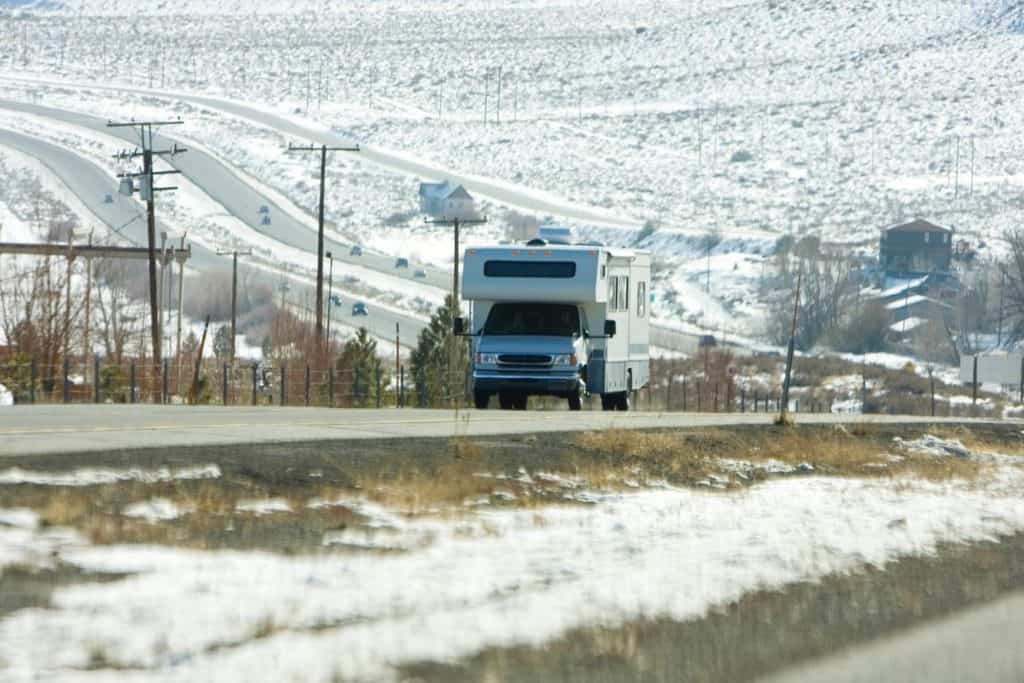
If you want to live and travel full-time in an RV, don’t let winter stop you! You can still travel in an RV during the winter, even in cold or snowy locations.
Here are some tips for RV winter travel to keep you safe out on the roads.
- Plan your travel days around inclement weather. If your campground checkout falls on a day of a winter storm, try to extend your stay. It’s never a good idea to be on the road during a winter storm if you don’t absolutely have to.
- Learn how to drive safely on snow and ice and what to do if you start to slip or slide.
- Get a good pair of winter tires on your motorhome or towing vehicle, if pulling a fifth wheel or travel trailer.
- Invest in snow chains. You never know when you will need them.
- Plan to stay at full hookup campgrounds often. If you rely on solar, you may not have a lot of power in the winter.
- Utilize travel-friendly RV skirting and insulation methods that are easy to set up and easy to take down and store while driving.
Conclusion: How to Live in an RV In Winter
Living comfortably and traveling safely in an RV comes down to a few main things:
- Insulating your RV.
- Heating your RV.
- Protecting your plumbing from freezing and cracking.
- Moisture and condensation management.
- Traveling safely and responsibly.
Truth be told, RVing is always a learning experience.
Learning how to stay warm and comfortable in your RV this winter will teach you a lot of lessons about how to be better prepared next winter, and so on and so forth.
Not every RVer needs to utilize every method talked about here–just do what you can with what you have.
Remember that the most important things to be aware of during winter RV living are:
- Protecting your RV plumbing from freezing.
- Being mindful of fire and carbon monoxide safety.
For everything else, you can bundle up to keep warm and avoid traveling during bad weather. As long as you keep yourself comfortable and avoid damage to your plumbing or health, your winter RV living experience will be a good one!
